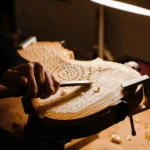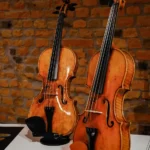The Battle Against Woodworm
Back to BlogThe Battle against Woodworm: An Original Restoration From The 19th Century
In the world of fine violins, the passage of time often reveals intriguing stories hidden within their frames. One such revolves around the renowned luthier Giovanni Battista Ceruti and the battle against woodworm damage that he encountered. Among his creations is a violin from the 1800s that passed through Amorim Fine Violins collection and bears witness to Ceruti’s resourcefulness and commitment to his craft. Through careful analysis led by me, it has been discovered that the restorations to combat woodworm damage were actually performed by Ceruti himself, revealing the challenging circumstances he faced during that era.
The Threat of Woodworm Damage
Woodworm, the larvae of certain types of beetles, poses a significant threat to fine violins. These tiny intruders can silently wreak havoc on the delicate wooden structure of instruments, causing irreparable damage. The discovery of woodworm infestation in historical violins often sparks a race against time to preserve the instrument’s integrity and protect its tonal qualities.
Ceruti’s Encounter
A particular violin from the 1800s by GB Ceruti stands out as a witness to the luthier’s encounter. Upon closer examination by Luiz Amorim, it became evident that the restorations to combat woodworm damage were executed by Ceruti himself. This revelation offers a unique insight into Ceruti’s challenges during his time. Access to quality materials was scarce, and economic constraints made it difficult for violin makers to discard or replace damaged wood. Thus, Ceruti took it upon himself to salvage the original wood and restore the violin.
During the 19th century, violin makers would purchase entire wood logs, allowing them to season naturally in the open air. The wood wasn’t specifically cut for violins, and considerations like the moon phase were unlikely to factor into their decisions. Consequently, the logs may have contained sap, increasing the likelihood of woodworm infestation. Moreover, these logs were not inexpensive, making it economically unfeasible to discard them due to woodworm damage. This forced makers like Ceruti to seek alternative solutions to address the issue.
Further strengthening this argument is the fact that the restoration work was concentrated around the delicate soundpost area of the violin. Recalling that this area is highly vulnerable and crucial to the instrument’s sound production. The scarcity of suitable materials may have compelled Ceruti to restore and preserve even the damaged wood in this critical region. In the world of violin making, craftsmen go to great lengths to keep the soundpost area intact, treating it as the most vulnerable and significant part of the instrument. The restoration efforts in this particular area highlight Ceruti’s commitment to salvaging every usable piece of wood and ensuring the overall integrity and functionality of the violin.
Additionally, during that era, the primary clientele for instruments shifted from the monarchy and the church to individual musicians. This shift prioritized sound quality over flawless craftsmanship, further influencing the maker’s approach.
Confirmation of Ceruti’s Restorations
A meticulous examination conducted by Luiz Amorim using UV light revealed that the restorations were carried out beneath the original varnish, the same as that of the top and ribs. Discussions with fellow violin makers and industry experts revealed a consensus: the restorations were indeed the handiwork of Ceruti himself.
Left: Back of the violin under UV light, the ‘orange’ part shows the untouched original varnish. Right: close-up under the UV light of the restoration done on the wood, beneath the original varnish.
The Ceruti violin, bearing the marks of both its original creator and his restoration efforts, holds immense historical and artistic value. Furthermore, it offers a unique glimpse into the challenges faced by luthiers of the time, who often had to rely on their own skills to overcome obstacles and preserve their creations.
The discovery of Ceruti’s personal restorations on the woodworm-damaged violin not only sheds light on the historical context but also serves as a reminder that every violin carries a unique story within its timeworn grains
Luiz Amorim is a Violin Maker and Co-Founder of Amorim Fine Violins Cremona. The article was originally published in the January 2024 edition of Strad Magazine. Read the digital version of the article









